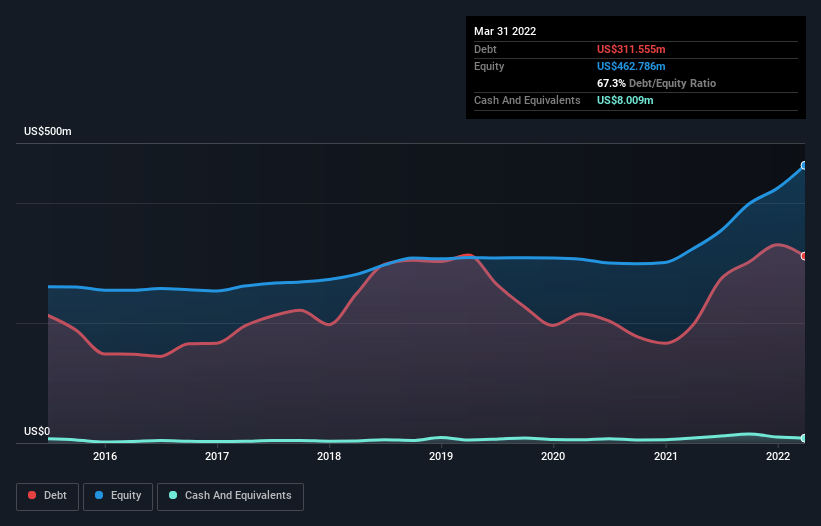- United States
- /
- Metals and Mining
- /
- NasdaqGS:ZEUS
These 4 Measures Indicate That Olympic Steel (NASDAQ:ZEUS) Is Using Debt Reasonably Well

Some say volatility, rather than debt, is the best way to think about risk as an investor, but Warren Buffett famously said that 'Volatility is far from synonymous with risk.' So it seems the smart money knows that debt - which is usually involved in bankruptcies - is a very important factor, when you assess how risky a company is. Importantly, Olympic Steel, Inc. (NASDAQ:ZEUS) does carry debt. But the more important question is: how much risk is that debt creating?
What Risk Does Debt Bring?
Generally speaking, debt only becomes a real problem when a company can't easily pay it off, either by raising capital or with its own cash flow. Ultimately, if the company can't fulfill its legal obligations to repay debt, shareholders could walk away with nothing. However, a more frequent (but still costly) occurrence is where a company must issue shares at bargain-basement prices, permanently diluting shareholders, just to shore up its balance sheet. Of course, plenty of companies use debt to fund growth, without any negative consequences. The first step when considering a company's debt levels is to consider its cash and debt together.
View our latest analysis for Olympic Steel
What Is Olympic Steel's Net Debt?
The image below, which you can click on for greater detail, shows that at March 2022 Olympic Steel had debt of US$311.6m, up from US$196.6m in one year. However, because it has a cash reserve of US$8.01m, its net debt is less, at about US$303.5m.

How Strong Is Olympic Steel's Balance Sheet?
We can see from the most recent balance sheet that Olympic Steel had liabilities of US$220.0m falling due within a year, and liabilities of US$360.9m due beyond that. On the other hand, it had cash of US$8.01m and US$313.1m worth of receivables due within a year. So its liabilities total US$259.8m more than the combination of its cash and short-term receivables.
This is a mountain of leverage relative to its market capitalization of US$404.4m. This suggests shareholders would be heavily diluted if the company needed to shore up its balance sheet in a hurry.
We measure a company's debt load relative to its earnings power by looking at its net debt divided by its earnings before interest, tax, depreciation, and amortization (EBITDA) and by calculating how easily its earnings before interest and tax (EBIT) cover its interest expense (interest cover). Thus we consider debt relative to earnings both with and without depreciation and amortization expenses.
Olympic Steel has a low net debt to EBITDA ratio of only 1.4. And its EBIT easily covers its interest expense, being 24.3 times the size. So you could argue it is no more threatened by its debt than an elephant is by a mouse. Better yet, Olympic Steel grew its EBIT by 566% last year, which is an impressive improvement. If maintained that growth will make the debt even more manageable in the years ahead. When analysing debt levels, the balance sheet is the obvious place to start. But ultimately the future profitability of the business will decide if Olympic Steel can strengthen its balance sheet over time. So if you want to see what the professionals think, you might find this free report on analyst profit forecasts to be interesting.
But our final consideration is also important, because a company cannot pay debt with paper profits; it needs cold hard cash. So we always check how much of that EBIT is translated into free cash flow. In the last three years, Olympic Steel created free cash flow amounting to 13% of its EBIT, an uninspiring performance. That limp level of cash conversion undermines its ability to manage and pay down debt.
Our View
Olympic Steel's interest cover was a real positive on this analysis, as was its EBIT growth rate. On the other hand, its conversion of EBIT to free cash flow makes us a little less comfortable about its debt. Considering this range of data points, we think Olympic Steel is in a good position to manage its debt levels. Having said that, the load is sufficiently heavy that we would recommend any shareholders keep a close eye on it. When analysing debt levels, the balance sheet is the obvious place to start. But ultimately, every company can contain risks that exist outside of the balance sheet. For example Olympic Steel has 5 warning signs (and 3 which don't sit too well with us) we think you should know about.
If, after all that, you're more interested in a fast growing company with a rock-solid balance sheet, then check out our list of net cash growth stocks without delay.
New: AI Stock Screener & Alerts
Our new AI Stock Screener scans the market every day to uncover opportunities.
• Dividend Powerhouses (3%+ Yield)
• Undervalued Small Caps with Insider Buying
• High growth Tech and AI Companies
Or build your own from over 50 metrics.
Have feedback on this article? Concerned about the content? Get in touch with us directly. Alternatively, email editorial-team (at) simplywallst.com.
This article by Simply Wall St is general in nature. We provide commentary based on historical data and analyst forecasts only using an unbiased methodology and our articles are not intended to be financial advice. It does not constitute a recommendation to buy or sell any stock, and does not take account of your objectives, or your financial situation. We aim to bring you long-term focused analysis driven by fundamental data. Note that our analysis may not factor in the latest price-sensitive company announcements or qualitative material. Simply Wall St has no position in any stocks mentioned.
About NasdaqGS:ZEUS
Olympic Steel
Processes, distributes, and stores metal products primarily in the United States, Canada, and Mexico.
Flawless balance sheet established dividend payer.
Similar Companies
Market Insights
Community Narratives



